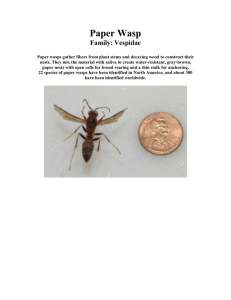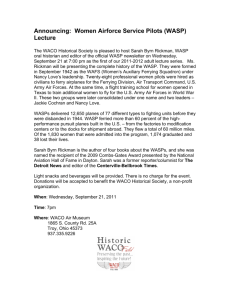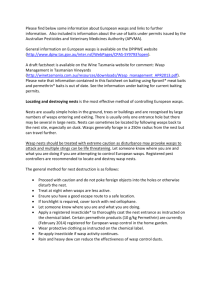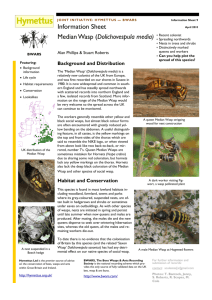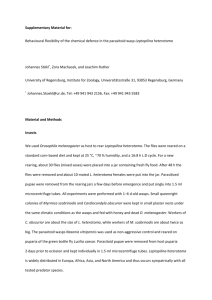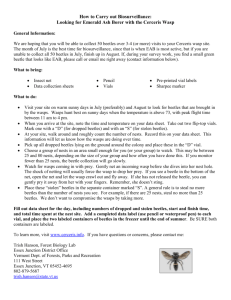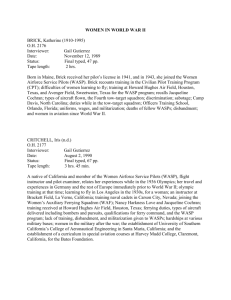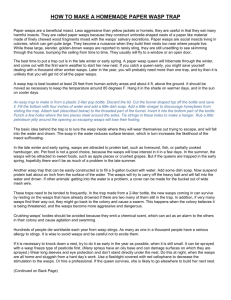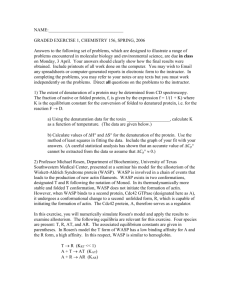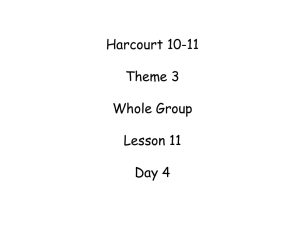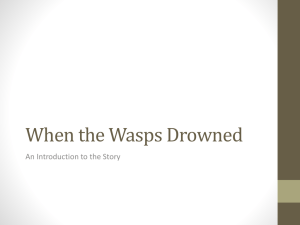SCIENCE BUGSCOPE-PeggyLan
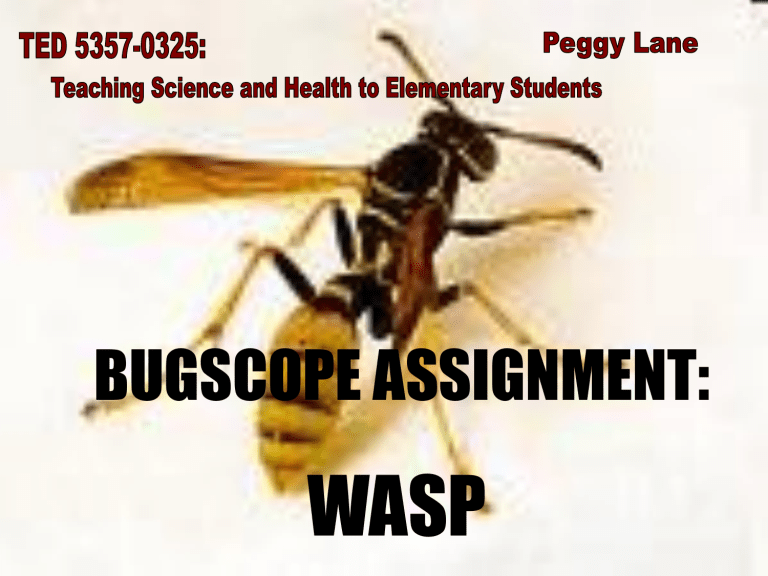
BUGSCOPE ASSIGNMENT:
WASP
STEP ONE: TWO WEBSITES
• Website #1: http://www.everythingabout.net/articles/biology/anim als/arthropods/insects/wasps/
• Website #2: http://www.kendall-bioresearch.co.uk/wasp.htm
STEP ONE: SUMMARY
A wasp is the name associated to a species of insects that include the sawflies, parasitic wasps, and stinging wasps. There are about 75,000 species of wasps and almost all of them are considered parasitic. Sawflies and parasitic wasps do not build nests. They lay their eggs on a host plant or animal and then leave to find food or more hosts for their eggs. The eggs develop on their own. However, the stinging wasp does build nests and live in societies. Their nests are mostly made of splinters of wood that are chewed into paper like material. It consists of several horizontal ties within and can become the size of a football or larger. For these wasps, the nests are where they develop their young. Many of these nests also have an outer covering where entire colonies live. This is what is known as the “hornets nest” that could house thousands of adult wasps. The nest usually hangs from an overhead structure or ceiling and has a hole at the bottom.
Only female wasps have a stinger. The queen wasps are large and have a poison-sac and sting at the tip of the abdomen. The male wasps do not. The offspring of the queen become the workers of the colony. The workers are responsible for building the nests and feeding the colony throughout the summertime. Most wasps are parasitic and eat other insects. Once the workers find a caterpillar, they paralyze it with their sting, bring it back to the nest, chew it up and feed it to their young. The adult wasps are entirely vegetarian. They feed on flower nectar, fruit or any other sweet nectar they can find. The wasps help protect pest populations by feeding on insects that destroy crops and other vegetation. In many ways, the wasp colonies reduce the need for pesticides to control agricultural pests.
At the end of summer, the colonies produce male and female wasps (young queens). Once they leave the nest to mate, the colony withers and dies due to lack of food in the autumn. Only the young, mated queen survives the winter via hibernation and begins to build new nests the following spring.
STEP TWO: MY PICTURE
STEP TWO: WHAT HAS CHANGED and WHY?
• Added honeycomb-like structures to the eyes of the wasp.
• Added “hooks” to the wasp claws as indicated using the Bugscope microscope.
• Added hair-like follicles on the wasp head, legs and wings. Added ribbed lines to the wasp wings.
• These changes were made as they were indicated using the Scanning Electron
Microscope that showed the eyes of the wasp were not smooth, but had a honeycomb structure throughout. The claws had noticeable sharp hooks at the end of them, I suppose for grasping onto objects and prey. The microscope also visibly showed hair-like follicles that encompassed the wasp from its head throughout its body, wings, and legs.
STEP THREE: WASP IMAGES
Wasp wing:
Wasp eye:
STEP THREE: WASP IMAGES
Wasp head:
Wasp claw:
All images supplied by: bugscope.beckman.illinois.
edu
STEP THREE: CA CONTENT
STANDARDS
• Grade Three: Life Sciences
Adaptations in physical structure or behavior may improve an organism’s chance for survival. As a basis for understanding this concept: a. Students know plants and animals have structures that serve different functions in growth, survival, and reproduction.
STEP THREE: HOW DOES IT APPLY?
The standard is applicable to the Bugscope learning environment because:
• Bugscope allows students to see in remarkable detail the different structures of the animal.
• Based on this observation, students are able to identify what function the structure (eye, head, wing, claw, etc.) might have in the growth, survival, and reproduction of the animal.
STEP THREE: AUTHENTICITY OF TECHNOLOGY
The use of microscopes and
Scanning Electron Microscopes allows students to observe animal structures with unprecedented detail.
Due to this, the students and scientists are able to discover important information on the particular animal that may not have been previously understood or recognized.
STEP THREE: LITERATURE SOURCES
1.
Chute, Eleanor. "Sixth-Graders Get to Look into Eye of What Bigs Them." Pittsburgh Post-
Gazette.
Pittsburgh, PA. 4 Nov. 2008.
2.
Dain, Alina. "Kids Catch Science Bug With
Bugscope." Medill Reports: Chicago.
Urbana,
IL. 13 May 2009.
3.
Heckel, Jodi. "UI's Bugscope Gives Area
Students Personal Look at Insects." The
News-Gazette.
Champaign, IL. 7 Oct. 2008.
STEP THREE: APPLICATION OF
BUGSCOPE
• Bugscope can be applied to
Mathematics as students observe and understand magnification of X - times normal size of animal under observation.
• Students can also apply the principals of Bugscope to Language-Arts instruction. The act of writing one’s observation, analysis, and evaluation in journals is an important part of the scientific process.
